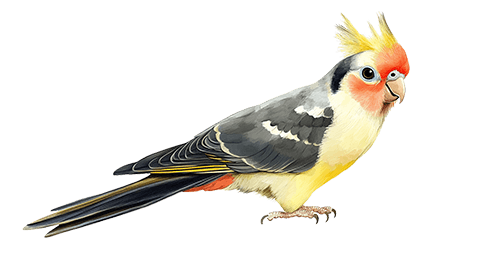All About Canaries: Feathered Friends with a Lot of Personality

Canaries are some of the most delightful and charming birds to keep as pets. With their bright feathers, sweet songs, and curious personalities, it’s no wonder they’ve been popular companions for hundreds of years. Whether you’re already a bird enthusiast or just curious about these little songbirds, let’s dive into what makes canaries so special.
What Canaries Are All About
Canaries belong to the finch family—small, perky birds that originally hail from the Canary Islands, Madeira, and the Azores (hence their name). Over time, they’ve been bred in various colors and types, but their basic traits remain the same.
They’re not only admired for their beauty but especially for their melodious songs. In fact, male canaries are often the ones who sing more frequently—especially during the breeding season—while females tend to be a bit quieter.
What Canaries Like—And What They Need
Canaries are pretty low-maintenance birds, making them a great choice for both new and experienced pet owners. But like any pet, they do have their preferences:
- Space to fly: Canaries are active birds, and they need enough room in their cages to flutter around. A spacious cage with horizontal bars for climbing is ideal.
- A good view: Canaries enjoy being placed in a part of the house where they can see lots of activity, but they also need a quiet space to relax and sleep.
- Fresh food and water: Like other finches, canaries mostly eat seeds, but they also love fresh vegetables, fruits, and leafy greens—like spinach, broccoli, or apples. You’ll want to avoid giving them avocado, which can be toxic to birds.
- Toys and stimulation: Although canaries aren’t as interactive with toys as parrots, they still enjoy some mental stimulation. Simple swings, perches, and small mirrors can keep them entertained.

Canaries and Humans—A Long History Together
Canaries have had a fascinating relationship with humans over the centuries. They were first bred in captivity in the 17th century by monks who took a liking to their song. By the time they spread across Europe, they became a status symbol—prized by royalty and nobility.
Perhaps the most famous role canaries played in history was in coal mines. Miners would bring canaries with them underground to detect poisonous gases. If the bird stopped singing or, in unfortunate cases, collapsed, it was a warning for the miners to evacuate. Thankfully, this practice has long been replaced by modern technology, but it gives you an idea of just how trusted these little birds were.

Activity Levels—More Than Just Sitting Pretty
You might think of canaries as delicate little creatures who spend most of their time perched in one spot—but that’s far from the truth. Canaries are lively, curious birds that enjoy flitting from perch to perch, especially when they’re in a spacious environment. They’re naturally independent, so unlike parrots, they don’t necessarily need human interaction to stay happy.
Males, in particular, are known for their singing—most of their activity is punctuated by their beautiful and varied melodies. While females can chirp and whistle, males are the true vocal stars. That being said, don’t expect them to be loud all the time. Canaries tend to be quieter in the winter and during molting season, when they’re shedding their feathers.

Types of Canaries—More Than Just Yellow
Canaries come in more varieties than you might expect! While the classic bright yellow canary is probably what comes to mind first, these birds come in a range of colors and breeds, each with its own unique traits:
- American Singer Canary: Known for its strong singing ability, this breed is a favorite among canary keepers for its pleasant, soft song.
- Colorbred Canaries: These canaries are bred specifically for their vibrant colors. They come in shades like red, orange, and white—perfect if you want a bird with a little extra flair.
- Gloster Canary: This type has a very distinct look—thanks to its “cap” of feathers that almost looks like a little bowl-cut haircut. They’re small, round, and make for cute companions.
- Roller Canary: Also known as the “German Roller,” this canary has a special way of singing that involves rolling the notes together in a very soothing, flowing song.
- Fife Fancy Canary: One of the smallest canaries, these birds are also known for their vibrant personalities and clear, pleasant song.

Fun Facts About Canaries
- They’re natural-born musicians: Males learn their songs from their fathers or neighboring males—it’s a skill passed down over generations!
- They’re solo birds: Unlike some other species, canaries don’t necessarily need a buddy in their cage. In fact, they can be territorial, so they often prefer being the sole bird in their space.
- Molting season is real: Once a year, canaries go through a molting phase where they shed and regrow their feathers. During this time, they might stop singing and can seem a little grumpy—don’t worry, it’s perfectly normal!
- Not all canaries sing: Female canaries don’t sing as much as the males, and in some cases, they don’t sing at all. So if you’re hoping for a bird with a beautiful voice, make sure you get a male.

Wrapping It Up
Canaries are wonderful, independent birds that can bring a lot of joy into a household with their cheerful songs and bright colors. Whether you’re looking for a singing companion or a beautiful bird to brighten up your home, canaries are a fantastic choice. Just make sure you give them the care and attention they need—and they’ll reward you with years of happiness.
Further reading: “Canary Crazy: How To Keep, Breed, & Care For Canaries” (Amazon affiliate link) by Robinda McDonald.
Affiliate Disclosure
This post may contain affiliate links, which means I earn from purchases made through links. Please see the privacy policy page for more details.







